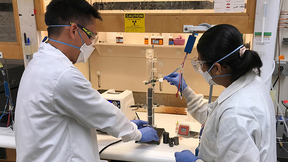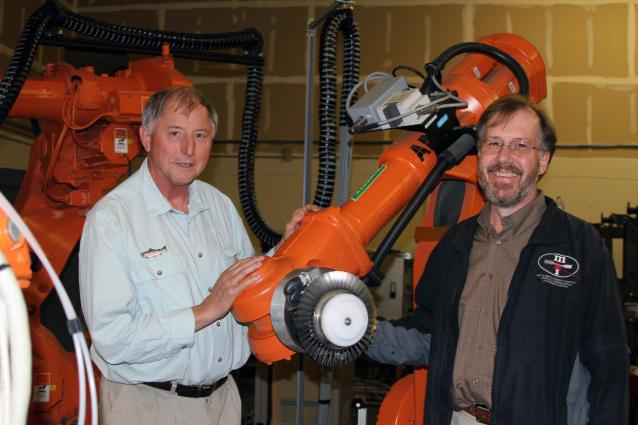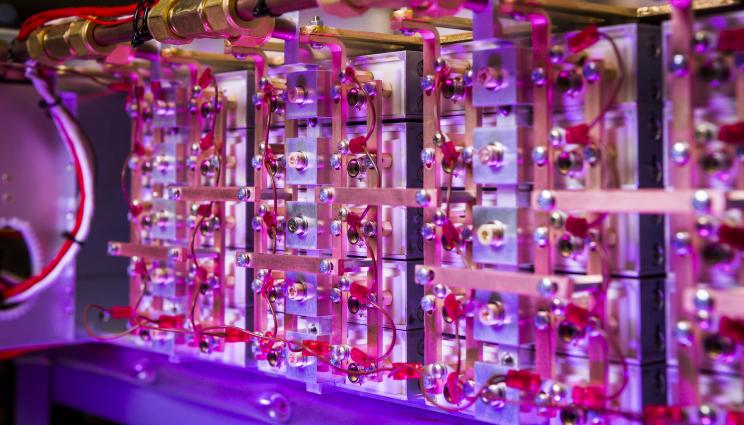Lasers, photonics and powerful partnerships
 (Download Image)
The commercialization of laser peening technology -- similar to working a metal’s surface with a ballpeen hammer -- has been one of the most successful transfers of Lawrence Livermore technology to industry. The laser peening technology, which was originally developed by Battelle in the 1970s and was first commercialized by LSP technologies in 1975, was upgraded by LLNL researchers working with Metal Improvement Co. Inc.
(Download Image)
The commercialization of laser peening technology -- similar to working a metal’s surface with a ballpeen hammer -- has been one of the most successful transfers of Lawrence Livermore technology to industry. The laser peening technology, which was originally developed by Battelle in the 1970s and was first commercialized by LSP technologies in 1975, was upgraded by LLNL researchers working with Metal Improvement Co. Inc.
The world’s most energetic laser sits in a secure, guarded federal laboratory, but its impact stretches far beyond the one-square-mile site of Lawrence Livermore National Laboratory (LLNL). Since the outset, technologies developed or improved at the Laboratory have led to industry-defining partnerships and products that make millions of Americans’ lives better every day. Even if they’ve never heard of them.
"Nearly all of us at this point have flown on an airplane with turbine blades that were laser peened with technology that Livermore commercialized years ago," said Craig Siders, senior scientist and commercial technology development leader in NIF & Photon Science’s Advanced Photon Technologies program. Laser peening -- using intense laser light to improve the quality of a material -- had been invented in the 1970s, but had not achieved significant market penetration until LLNL introduced a new laser architecture that provided critical new functionality to the technology. Laser peening is commonplace now, thanks in part to Laboratory research that was spun off into the private sector.
"It’s technology that’s absolutely in the hands of industry today, and the Lab is now out of the peening business, because it’s the right thing to do," Siders added. "LLNL’s innovations in laser technology were a critical component in making peening a success story."
In 2003, former LLNL scientists Lloyd Hackel and Brent Dane, together with LLNL CRADA partner Metal Improvement Company (MIC), today part of Curtiss-Wright Corporation, brought the benefits of laser peening to the economy as a whole. The Laboratory’s commercialization process worked: Lawrence Livermore helped develop a cutting-edge technology until it was mature enough to stand on its own. Today, laser peening can exponentially extend the lifespan of an F-22 fighter jet’s airframe. MIC has treated jet engine fan blades on every Airbus A340 passenger plane and hundreds of Boeing 777s and 787s. It’s the third best royalty-producing technology in Lab history.
And now, LLNL is offering the opportunity to license and commercialize an extension of laser-peening technology called high velocity laser accelerated deposition (HVLAD) for controlled laser-driven explosive bonding. HVLAD was selected by R&D Magazine as a winner of an R&D 100 Award in 2012.
"We’re in the process of satisfying the primary goals of the Lab -- pursuing national security, stockpile stewardship and fundamental science," said David Dawes, a business development executive in LLNL’s Innovation and Partnerships Office (IPO). "All of these things can help generate spinoffs that are commercially important."
Dawes is a primary conduit between LLNL and industry. When scientists believe they have a breakthrough, they often come to Dawes for advice. Whether that conversation leads to a record of invention, a patent or a Collaborative Research and Development Agreement (CRADA), he’s instrumental in helping keep up with the laser and optics industry and matching research with opportunity. Many of NIF’s 40,000 brand new, specialized optical components represent commercialization opportunities, thanks to the new technologies developed to create them. As the Laboratory advances each dimension of laser and optics technology, companies can follow behind and adopt them as they become available.
"All of these features involve leading-edge technologies that are important to the laser industry as a whole as they scale up their power levels," Dawes says. "There’s marketable technologies there that we’re currently talking to a number of companies about licensing." For other examples of current laser and optics technologies available for commercialization, see the IPO website.
In particular, Dawes brings 35 years of experience in the industry (and some patents of his own) to bear on IPO’s work connecting research with companies. Maintaining long-standing relationships with industry and academic leaders, setting up visits to Livermore and monitoring trade and scientific journals are important tricks of Dawes’ trade. IPO screens every paper slated for journal publication in order to identify possibilities for future commercialization. Details on ongoing CRADAs and licensing are scarce, but the Laboratory’s track record speaks for itself.
"The Lab has had a significant impact, historically, on the market," said Siders. "There’s a lot of goodwill out there, built up with past success stories like peening."
Pushing the frontiers in lasers
Anticipating the next generation of lasers is especially fertile ground for partnerships with LLNL’s NIF & Photon Science researchers. Scientists expect these lasers to be so powerful, current optics technologies won’t be able to withstand them.
"When I was a professor, I called this the first law of directed energy," said Siders. "Thou Shalt Destroy the Target Before You Destroy the Laser."
A current CRADA with Electro-Optics Technology (EOT) aims to address one of these. Known for their diode-like Faraday isolators -- permitting light to pass in one direction only while preventing harmful backward propagation -- EOT, among other industry leaders, got a call from Laboratory researchers with experience in high-power laser performance and component cooling looking for pushing the limits of isolator technologies. EOT was looking to advance applications of new materials, which fit perfectly into the needs for high-power isolators. Together, EOT and LLNL are close to producing a marketable product that will benefit the laser industry as a whole and prepare the Laboratory for advanced high-power laser systems.
One such system is the new HAPLS pulsed-laser being installed in the European Union’s Extreme Light Infrastructure (ELI) Beamlines facility in the Czech Republic. HAPLS (the High-Repetition-Rate Advanced Petawatt Laser System designed, developed and delivered by LLNL) integrates a number of new, efficient, high-power laser and optical technologies that Siders believes will eventually lead to the lasers necessary for inertial fusion energy. It’s a powerful tool for its customer, ELI Beamlines, but it’s also a window for scientists into the future of high-power pulsed lasers and a possible fusion power plant.
"We’re actually looking to provide benefits back from investments that this nation and the Department of Energy have made over four or five decades of research into inertial confinement fusion and inertial fusion energy," said Siders. While luck is always a component, he added that strategy and ongoing communication are key to maintaining fruitful partnerships.
"By working with industry in that way, we can get products on the market that everyone can benefit from," said Siders. "That helps move the nation’s laser technology capabilities forward. That’s a good news story."
In addition to the significant benefits Lawrence Livermore’s laser and optics research can provide to industry, commercialization can also have a tremendous impact on the scientists themselves.
"I often tell folks here that there’s a future where they could walk into almost any lab in the world, point to something and say ‘hey, that’s my work,’" said Siders. "That’s immensely rewarding."
-Ben Kennedy
Contact
 Stephen Wampler
Stephen Wampler
[email protected]
(925) 423-3107
Related Links
Industrial Partnerships at LLNLTags
Industry CollaborationsTechnology Transfer
Featured Articles









